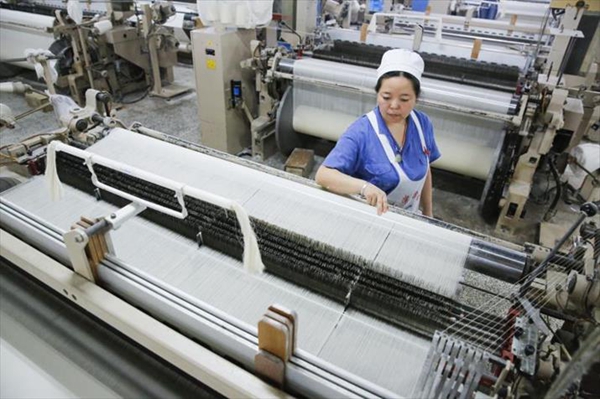Central SOEs' success depends on asset-light strategy
- By Tan Haojun
 0 Comment(s)
0 Comment(s) Print
Print E-mail Beijing Review, April 10, 2017
E-mail Beijing Review, April 10, 2017
|
|
|
A workshop of the state-owned Shaanxi Baomian Textile Group in Baoji, Shaanxi Province (XINHUA) |
On March 12, Xiao Yaqing, Chairman of the State-owned Assets Supervision and Administration Commission of the State Council (SASAC), urged centrally administered state-owned enterprises (SOEs) to strictly control haphazard investment practices and consider market rules when determining their development strategies. Xiao said central SOEs have to increase profits and improve profitability, otherwise fundamentally reducing their debt levels and eliminating the associated risks will be impossible.
In previous years, central SOEs reduced their asset-liability ratios by expanding asset scale and investment. Pressure brought by the global economic downturn, however, exposed problems that such expansion had concealed, and the ratios soon started to rise again.
As supervisory authorities have strengthened their oversight in recent years, expansion of investment and assets by central SOEs has been slowed, and their debt ratios have stopped growing. However, the high debt ratios have yet to be reduced. According to the SASAC, the average debt ratio of the 102 central SOEs stands at 66.6 percent. Among them, 12 have debt ratios of over 80 percent, and four have ratios surpassing 85 percent.
Central SOEs accumulated their debts while enjoying much lower financing costs than other types of businesses, especially small and medium-sized enterprises (SMEs). If central SOEs' financing costs were as high as those of SMEs, their debt ratios would be even higher.
How should central SOEs improve their operational efficiency, profitability and market competitiveness in order to continue to play their role as a pillar of the national economy? Central SOEs must be encouraged to adopt an asset-light strategy and to depend less on asset scale expansion.
They should first curb blind expansion, investment and decision making. In the years before the global financial crisis, central SOEs explosively expanded their business scale. Many of their present asset bubbles were caused and most of their debts were contracted in that period. Many central SOEs possess a lot of land which has little or no investment. Large amounts of land thus remain unused, and a lot of bank credit lacks reliable sources of repayment. The government should issue stronger measures concerning the development of central SOEs to curb their blindness in investment and decision making.
It is also important to intensify the reform of central SOEs and transform them into real market entities. The opening up of markets should be facilitated and market access thresholds lowered further, allowing more non-state capital to enter monopoly sectors in order to press central SOEs to improve their technology, asset structure and quality of growth. Core competitiveness should be the most important criterion for evaluating central SOEs.
In a modern market economy, real market players will not excessively rely on asset scale expansion, but focus on improving efficiency and profitability. Once central SOEs become such market participants, reliant upon market forces for survival and growth, they will make more prudent decisions on strategy and investment.
The author is a financial commentator and the article was first published in Securities Times







Go to Forum >>0 Comment(s)